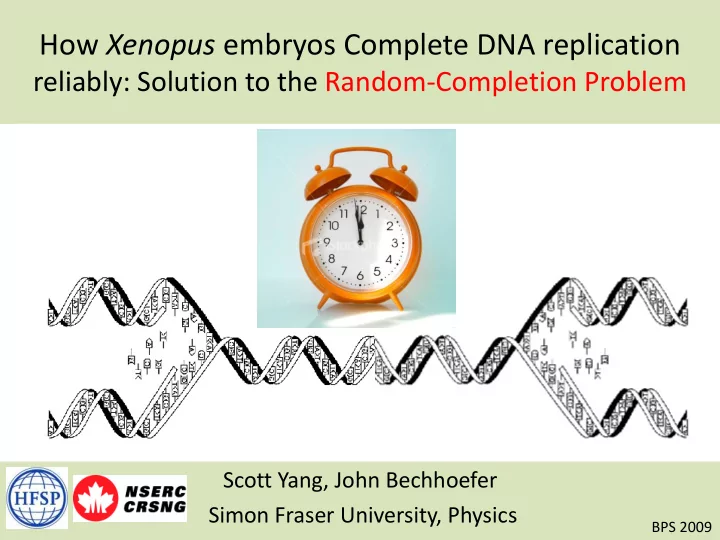

How Xenopus embryos Complete DNA replication reliably: Solution to the Random-Completion Problem Scott Yang, John Bechhoefer Simon Fraser University, Physics BPS 2009
Outline • DNA replication in frog embryos • Our model • Results
Xenopus http://embryology.med.unsw.edu.au/OtherEmb/frog1.htm
OR No S/M checkpoint Healthy Mitotic M catastrophe ~5 min. Replication Embryonic progress Cell Cycle Cell cycle time S driven ~20 min. biochemically
The Random Completion Problem • Initiations are stochastic • Typical replication time ≈ 20 min. • Dead if > 25 min. • Occurs only 1 in 250 times! • How is this possible?
Our Model I(t) = number of initiations / non-replicated length / time S phase Non-replicated Spatially random origins
Our Model Last Coalescence Replication = Event end-time S phase Non-replicated Spatially random origins
Coalescence distribution 0 10 20 Extreme Value time (min.) Theory End-time distribution 20 25 30 end-time (min.) Random completion problem
Coalescence distribution 0 10 20 Extreme Value time (min.) Theory Gumbel End-time distribution 20 25 30 end-time (min.) Random completion problem
Results -function constant distribution linear quadratic t* End-time Increasing I(t) narrows distribution
Controlling the end-time distribution • Why increasing I(t) narrow distribution? – -function case GAP – mind the gap – End-time distr. meets constraints v, I(t), # origins
Does spatial regularity matter? Periodic spacing Threshold Xenopus Random spacing Regularity only has a minor effect .
Conclusion • Modelled replication • EVT random completion problem • Increasing I(t) helps timing control • Spatial regularity unimportant • Does nature adopt an optimized I(t) ? Ref: S.C.-H. Yang & J. Bechhoefer, PRE 78 , 041917 (2008) Commentary: S. Jun & N. Rhind, Physics 1 , 32 (2008)
Recommend
More recommend